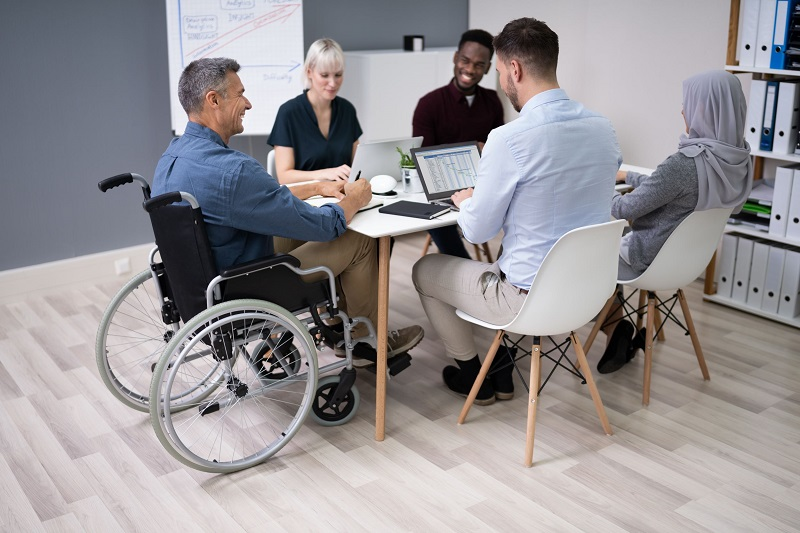ATD Blog
The Language of Disability in the Workplace
Wed Jan 19 2022

According to the World Health Organization, over one billion people live with some form of disability, which corresponds to about 15 percent of the world’s population. Yet many of us struggle with how to talk about disability in the workplace, unsure what words or phrases to use and which ones to avoid. Part of our hesitation stems from differing direction on the most respectful way to refer to disability.
While language specifics vary across cultures, opportunities exist for everyone to develop greater awareness about disabilities in the workplace. Respecting the lived experiences of others allows us to develop stronger connections and build more inclusive teams.
While these conversations can be difficult, there are many useful guidelines around navigating disability language. Andrew Pulrang, a staff contributor for Forbes Magazine, writes articles about disability and his perspective as a writer with disabilites. He refers to “competing schools of thought on disability language” and offers the following suggestions:
Recognize inappropriate terms and stop using or tolerating them. These words vary based on culture and language but are often widely known and used as insults. Terms like “crazy,” “retarded,” and “cripple” are universally recognized as unacceptable and must be avoided.
Be factual, descriptive, and simple, not condescending or sentimental. Utilize the words disabled or disability, and, depending on the context and people involved, be specific about certain disabilities such as blindness, deafness, or usage of a wheelchair.
Respect disabled people’s language preferences. When you’re not sure, listen to how they refer to themselves or others in the disability community.
People-First vs Identity-First Language
In the disability community, there are two approaches for referring to disabilities: People-First Language and Identity-First Language. So, how do you know which to choose?
People-First Language emphasizes the person first, not their disability. The key to remember is with—people with disabilities. When using People-First Language, you talk about children with epilepsy or an adult with a learning disability.
Identity-First Language puts the disability first because it is a central and integral part of life. For Identity-First Language, you’d say a blind person or a deaf athlete.
Default to People-First Language if you are unsure or the situation doesn’t allow confirmation of language preferences.
Being sensitive to these differences is critical when talking about disability in the workplace and how we incorporate more inclusive language. The National Center on Disability and Journalism created a helpful style guide that goes into some of the history behind disability language and how it looks in other cultures and countries. The American Psychological Association also stresses that “the overall principle for using disability language is to maintain the integrity, worth, and dignity of all individuals as human beings.”
Disability in the Workplace Language Around the World
It is imperative to build our inclusive vocabulary as we connect with different cultures. Below are some common phrases within the disability community and their cross-culture variations:
Disabled People/People with Disabilities. In the United States, both terms are used but some communities prefer one over the other. In Asia, many prefer the term “people with disabilities,” but this may vary depending on the region. In Great Britain, many prefer the term “disabled people.” With these regional differences, it’s a great idea to ask when the opportunity is there.
Examples:
People with disabilities are hired at disproportionately low rates compared to those who do not have disabilities.
Disabled people have the same rights to access as those who do not have disabilities.
Someone Who Uses a Wheelchair. In most cultures, the term “wheelchair user” is preferable to “wheelchair-bound” or “confined to a wheelchair.” This word change recognizes that people who use wheelchairs are not “bound” to their mobility device. It is a choice they have made.
Examples:
Gretchen, our new hire, is a wheelchair user, so be sure the ramp is up to code.
Our colleague, Amar, is a wheelchair user. What accommodations do you have ready for him when we visit the plant?
Able-Bodied. This term implies that people with disabilities don’t have “able” bodies. Most cultures prefer more neutral terms such as “non-disabled” or “not living with a disability.”
Examples:
If you’re not living with a disability, you might wonder why the PowerPoint was adjusted, but as a blind man, I can assure you that I appreciate the changes.
Those of you who are non-disabled, please take care to push in your chairs at the end of the day so we can accommodate wheelchair users.
Words Matter
Even if this is the first time you’ve read about the schools of thought on disability in the workplace language, this is a great opportunity to put it into practice. Pay attention to how disabled people refer to themselves or their communities. Learn ways to change your vocabulary when talking about disability. And, when possible, engage in meaningful conversation with someone who identifies as disabled.
Creating a safe space for employees with disabilities to bring their authentic selves and not be subject to inappropriate language requires all of us to take the necessary steps to spark change. And change requires learning and growth. Offering your people approachable, actionable learning around diversity and inclusion, which embraces the wide variety and beauty of differences found in today’s workplace, is a great way to start the journey.

